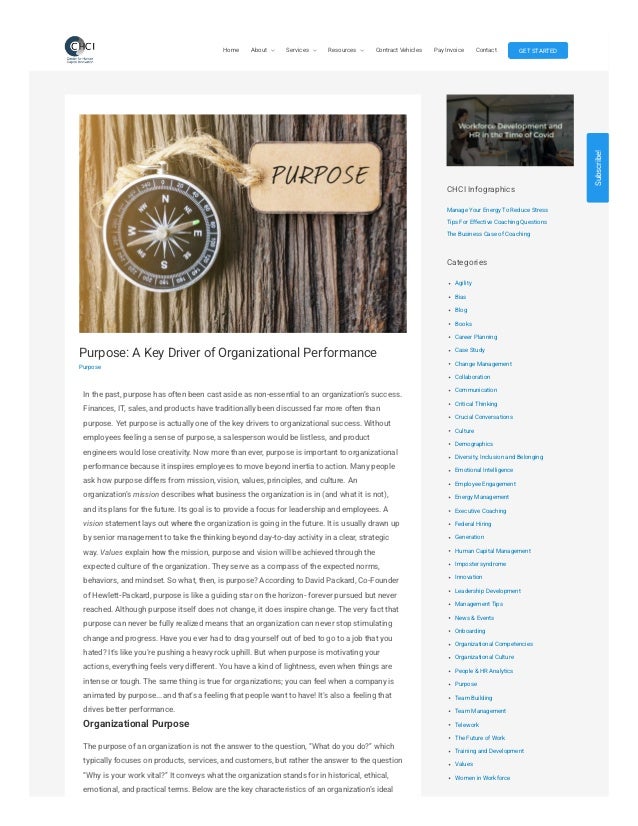
Purpose: A Key Driver of Organizational Performance.pdf
- 1. Purpose: A Key Driver of Organizational Performance Purpose In the past, purpose has often been cast aside as non-essential to an organization’s success. Finances, IT, sales, and products have traditionally been discussed far more often than purpose. Yet purpose is actually one of the key drivers to organizational success. Without employees feeling a sense of purpose, a salesperson would be listless, and product engineers would lose creativity. Now more than ever, purpose is important to organizational performance because it inspires employees to move beyond inertia to action. Many people ask how purpose differs from mission, vision, values, principles, and culture. An organization’s mission describes what business the organization is in (and what it is not), and its plans for the future. Its goal is to provide a focus for leadership and employees. A vision statement lays out where the organization is going in the future. It is usually drawn up by senior management to take the thinking beyond day-to-day activity in a clear, strategic way. Values explain how the mission, purpose and vision will be achieved through the expected culture of the organization. They serve as a compass of the expected norms, behaviors, and mindset. So what, then, is purpose? According to David Packard, Co-Founder of Hewlett-Packard, purpose is like a guiding star on the horizon- forever pursued but never reached. Although purpose itself does not change, it does inspire change. The very fact that purpose can never be fully realized means that an organization can never stop stimulating change and progress. Have you ever had to drag yourself out of bed to go to a job that you hated? It’s like you’re pushing a heavy rock uphill. But when purpose is motivating your actions, everything feels very different. You have a kind of lightness, even when things are intense or tough. The same thing is true for organizations; you can feel when a company is animated by purpose… and that’s a feeling that people want to have! It’s also a feeling that drives better performance. Organizational Purpose The purpose of an organization is not the answer to the question, “What do you do?” which typically focuses on products, services, and customers, but rather the answer to the question “Why is your work vital?” It conveys what the organization stands for in historical, ethical, emotional, and practical terms. Below are the key characteristics of an organization’s ideal CHCI Infographics Manage Your Energy To Reduce Stress Tips For Effective Coaching Questions The Business Case of Coaching Categories Agility Bias Blog Books Career Planning Case Study Change Management Collaboration Communication Critical Thinking Crucial Conversations Culture Demographics Diversity, Inclusion and Belonging Emotional Intelligence Employee Engagement Energy Management Executive Coaching Federal Hiring Generation Human Capital Management Imposter syndrome Innovation Leadership Development Management Tips News & Events Onboarding Organizational Competencies Organizational Culture People & HR Analytics Purpose Team Building Team Management Telework The Future of Work Training and Development Values Women in Workforce Subscribe! GET STARTED Home About Services Resources Contract Vehicles Pay Invoice Contact
- 2. ← Previous Post purpose statement, which is: • Central and enduring to the culture of the organization • Inspiring and unifying • The answer to the question, “Why is this work vital?” A purpose statement should be brief so employees can remember it and use it to guide their daily actions. It should also be broad in scope to allow the organization to adapt over time to a changing world, while its central focus remains constant. Here are a few examples of organizational purpose statements: ING – Empowering people to stay a step ahead in life and in business Kellogg – Nourishing families so they can flourish and thrive Insurance Australia Group (IAG) – To help people manage risk and recover from the hardship of unexpected loss REA Group – To make the property process simple, efficient, and stress-free for people buying and selling a property Southwest Airlines – To connect people to what’s important in their lives through friendly, reliable, and low-cost air travel CVS – Helping people on their path to better health In the current world, employee engagement is crucial. Employees need to work with a sense of purpose that comes from knowing that what they do affects others in the organization. Engaged employees relish what they do and are more productive. Purpose provides clarity and stimulates innovation. Embracing clarity can open the door to allowing employees to see possibilities that they wouldn’t have otherwise seen. They understand the organization’s expectations of them and the reasons behind those expectations. It empowers them to deliberate new methods of doing their work to meet the organizational mission. We would love to hear from you! What’s your organizational purpose? How is purpose driving your motivation levels and enhancing the organizational performance? Let’s share experiences. Leave a comment below, send me an email, or find me on Twitter. Subscribe To Our Newsletter Recent Posts Purpose: A Key Driver of Organizational Performance Career Planning: Creating a Professional Development Plan Best Practices for Hiring Gen Z Longevity’s Impact on Workforce Education Future of Work for Product Managers Search … Increase The Effectiveness Of Your Leaders And Employees. S I G N U P H E R E ! At A Glance CHCI is dedicated to improving organizational performance through improved people management. We specialize in Strategic Consulting, People Analytics, Executive Coaching, Training and Education, and Leadership Development. Solutions Training & Education Human Capital Management Consulting Executive Coaching People Analytics Leadership Development Speaking Engagements Resources Subscribe to our Newsletter Subscribe! Blog Pay Invoice CHCI Service Brochure Subscribe! Get In Touch Office Location 44 Canal Center Plaza, Suite G1 Alexandria, VA 22314 (Washington DC Area) (571) 970-4250 Ext. 113 Contact us Copyright © 2022 Center for Human Capital Innovation | Privacy Policy | Terms & Conditions
